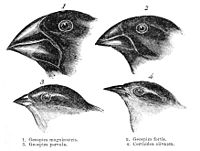
Origin and Consequences of Chromosomal Inversions in the virilis Group of Drosophila
Sign Up to like & getrecommendations! Published in 2018 at "Genome Biology and Evolution"
DOI: 10.1093/gbe/evy239
Abstract: Abstract In Drosophila, large variations in rearrangement rate have been reported among different lineages and among Muller’s elements. Nevertheless, the mechanisms that are involved in the generation of inversions, their increase in frequency, as well… read more here.
Keywords: drosophila; virilis group; inversions virilis; origin consequences ... See more keywords

Temperature-associated selection linked to putative chromosomal inversions in king scallop (Pecten maximus)
Sign Up to like & getrecommendations! Published in 2022 at "Proceedings of the Royal Society B: Biological Sciences"
DOI: 10.1098/rspb.2022.1573
Abstract: The genomic landscape of divergence—the distribution of differences among populations or species across the genome—is increasingly characterized to understand the role that microevolutionary forces such as natural selection and recombination play in causing and maintaining… read more here.
Keywords: scallop pecten; putative chromosomal; king scallop; pecten maximus ... See more keywords

Pooled ecotype sequencing reveals candidate genetic mechanisms for adaptive differentiation and reproductive isolation
Sign Up to like & getrecommendations! Published in 2017 at "Molecular Ecology"
DOI: 10.1111/mec.13881
Abstract: The early stages of speciation are often characterized by the formation of partially reproductively isolated ecotypes, which evolve as a by‐product of divergent selective forces that are endemic to different habitats. Identifying the genomic regions,… read more here.
Keywords: pooled ecotype; ecotype sequencing; differentiation; sequencing reveals ... See more keywords

Comparative linkage mapping uncovers recombination suppression across massive chromosomal inversions associated with local adaptation in Atlantic silversides.
Sign Up to like & getrecommendations! Published in 2022 at "Molecular ecology"
DOI: 10.1111/mec.16472
Abstract: The role of recombination in genome evolution has long been studied in theory, but until recently empirical investigations had been limited to a small number of model species. Here we compare the recombination landscape and… read more here.
Keywords: adaptation; recombination; chromosomal inversions; linkage ... See more keywords

Experimental introgression in Drosophila: Asymmetric postzygotic isolation associated with chromosomal inversions and an incompatibility locus on the X chromosome
Sign Up to like & getrecommendations! Published in 2022 at "Molecular Ecology"
DOI: 10.1111/mec.16803
Abstract: Interspecific gene flow (introgression) is an important source of new genetic variation, but selection against it can reinforce reproductive barriers between interbreeding species. We used an experimental approach to trace the role of chromosomal inversions… read more here.
Keywords: introgression; incompatibility locus; chromosome; chromosomal inversions ... See more keywords

Frequency, Origins, and Evolutionary Role of Chromosomal Inversions in Plants
Sign Up to like & getrecommendations! Published in 2020 at "Frontiers in Plant Science"
DOI: 10.3389/fpls.2020.00296
Abstract: Chromosomal inversions have the potential to play an important role in evolution by reducing recombination between favorable combinations of alleles. Until recently, however, most evidence for their likely importance derived from dipteran flies, whose giant… read more here.
Keywords: plant; evolutionary role; role; frequency origins ... See more keywords